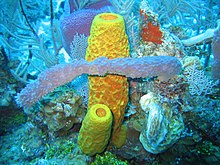Niphates digitalis
| Pink vase sponge | |
|---|---|

| |
| The pink vase sponge (Niphates digitalis) is seen in the back of the photo, behind three other species of sponges. | |
| Scientific classification | |
| Domain: | Eukaryota |
| Kingdom: | Animalia |
| Phylum: | Porifera |
| Class: | Demospongiae |
| Order: | Haplosclerida |
| Family: | Niphatidae |
| Genus: | Niphates |
| Species: | N. digitalis
|
| Binomial name | |
| Niphates digitalis (
Lamarck , 1814) | |
| Synonyms | |
|
List
| |
Niphates digitalis, commonly known as the pink vase sponge, is a species of
sea sponge belonging to the family Niphatidae. It is native to the Florida Keys, The Bahamas, and the Caribbean including the Netherlands Antilles.[1] The species was first described by Jean-Baptiste Lamarck in 1814.[2]
Characteristics
The pink vase sponge is a demosponge that can grow up to 50 cm in height and width, but is more commonly smaller. It is normally vase-, tube-, or cup-shaped with a narrow base and broader top, and somewhat flattened when viewed in cross section. Rarely, it can grow as a fan shape.[3] Despite its name, the colour has been observed as blue, gray, and lavender, as well as "purplish to pink".[1] The surface is coarse and porous with 6-mm-long conules or spines.[3]
Chemistry
Compounds extracted from the pink vase sponge have been investigated for their possible use in the treatment of castration recurrent
1,8-diazabicycloundec-7-ene can be isolated from this sponge.[5]
References
- ^ a b "Niphates digitalis". Encyclopedia of Life. Retrieved 13 April 2016.
- ^ "Niphates digitalis (Lamarck, 1814)". World Porifera Database. Retrieved 13 April 2016.
- ^ a b "Niphates digitalis (Lamarck, 1814) Haplosclerida, Niphatidae". Portol.org. Retrieved 13 April 2016.
- PMID 22148427.
- PMID 27006813.
